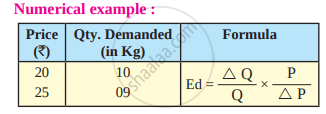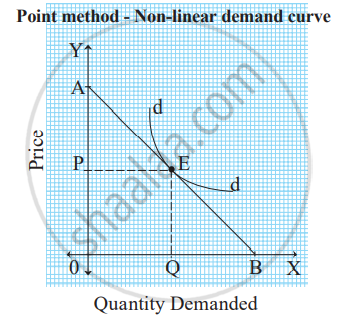Topics
Elementary Theory of Demand
- Concept for Demand
- Types of Demand
- Demand Schedule
- Demand Curve
- Determinants of Demand Or Demand Function
- Law of Demand
- Assumptions of Law of Demand
- Exceptions to the Law of Demand
- Movement Along and Shifts in the Demand Curve
- Shift in Demand Curve
Demand and Supply: Basic Concepts
Factors of Production: Basic Concepts
Elasticity of Demand
Theory of Supply
- Concept of Supply
- Difference Between Supply and Stock
- Types of Supply
- Determinants Or Factors Governing the Supply
- Supply Function
- Supply Schedule
- Supply Curve
- Law of Supply
- Assumptions of the Law of Supply
- Exceptions to the Law of Supply
- Why Does the Supply Curve Slopes Upward to the Right
- Movement Along the Supply Curve and Shift in Supply Curve
- Movement Along the Supply Curve: Variations (Extension Or Contraction) of Supply
- Shift in Supply Curves
- Distinction Between Change in Quantity Supplied (Or Movement Along Supply Curve and Change in Supply Or Shift of the Supply Curve)
- Distinction Between Expansion in Supply and Increase in Supply
- Distinction Between Contraction in Supply and Decrease in Supply
- Elasticity of Supply
Alternative Market Structures: Basic Concepts
Elasticity of Supply
- Elasticity of Supply
- Degrees of Elasticity of Supply
- Measurement of Elasticity of Supply
- Factors Affecting Elasticity of Supply
The State and Economic Development
Factors of Production
- Production is Transformation
- Meaning of Production Mechanism
- Factors of Production
- Factors of Production - Land
- Factors of Production: Labour
- Factors of Production: Capital
- Factors of Production Entrepreneur
- Relative Importance of Different Factors of Production
Money and Banking: Basic Concepts
Land
- Land
- Characteristics of Land
- Functions of Land
- Importance of Land
- Productivity of Land
- Factors Affecting Productivity of Land
Destruction of Ecosystem
- Ecosystem
- Industrialisation
- Urbanisation
- Migration
- Dwelling Units
- Mining
- Construction of Dams
- Shifting Cultivation
- Causes of Destruction of Ecosystem
Labour
- Factors of Production: Labour
- Characteristics of Labour
- Labour: an Important Factor of Production
- Entrepreneur - Special Type of Labour
- Labour and Economic Activities
- Division (Specialisation) of Labour
- Types of Division of Labour
- Advantages of Division of Labour
- Disadvantages of Division of Labour
- Necessary Conditions for the Division of Labour
- Efficiency of Labour
- Reasons for Low Efficiency of Labour in India
- Suggestions for Improving the Efficiency of Indian Workers
Capital and Capital Formation
- Factors of Production: Capital
- Difference Between Capital and Other Related Concepts
- Differences Between Land and Capital
- Differences Between Capital and Labour
- Characteristics of Capital
- Types of Capital
- Functions of Capital
- Capital Formation
- Is Land Capital?
- Factors Influencing Or Affecting Capital Formation
- Significance of Capital Formation
- Causes of Low Rate of Capital Formation
- Suggestions to Raise Rate of Capital Formation
Entrepreneur
- Factors of Production Entrepreneur
- Functions of an Entrepreneur
- Difference Between Entrepreneur and Organisation
- Distinction Between Labour and Entrepreneur
- Distinction Between Capitalist and Entrepreneur
- Qualities to Be a Successful Entrepreneur
- Role of Entrepreneurs in Economic Development
Nature and Structure of Markets
- Alternative Market Structures
- Concept of Market
- Characteristics of Market
- Forms of Market Structure
- Factors Determining Forms of Market
- Market Structures
- Extent of Market
- Similarities Between Monopolistic Competition and Perfect Competition
- Similarities Between Monopolistic Competition and Monopoly
The State and Economic Development
- The State and Economic Development
- Introduction of Public and Private Sector
- Functions of the State in Promoting Economic Development
- Role of State in Economic Development
Instruments of State Intervention
- The Instruments of State Intervention
- Meaning of Fiscal Policy
- Objectives of Fiscal Policy
- Instruments of Fiscal Policy
- Types of Taxes
- Monetary Policy
- Distinction Between Monetary and Fiscal Policy
Public Sector Enterprises
- Public Sector Enterprises
- Role of Public Sector Enterprises
- Problems of Public Sector Enterprises/Reasons for Declining Popularity of Public Sector
- Suggestions to Improve the Efficiency of Public Sector Enterprises
Privatization of Public Enterprises
- Privatization of Public Enterprises
- Need for Privatisation
- Rationale of Privatisation in India
- Reasons in Favour of Privatisation
- Pre-requisites for Privatisation
- Limitations of the Privatisation
- Suggestive Framework for Privatisation
- Arguments for Privatisation Or Disinvestment
- Arguments Against Privatisation (Or Disinvestment)
- Privatisation in India
Money and Inflation
- Money
- Concept for Barter System
- Inconveniences Or Difficulties of Barter System
- Functions of Money
- Importance of Money
- Types of Money
- Forms of Money
- Features of Money
- Introduction of Inflation
- Characteristics of Inflation
- Types of Inflation
- Causes of Inflation
- Effects of Inflation
- Anti-inflationary Measures
Banking : Commercial Banks and Central Bank
- Meaning of Commercial Banks
- Importance of Banks
- Commercial Banks: Functions
- Money Creation Or Credit Creation by the Commercial Banking System
- Nationalisation of Banks
- Meaning of Central Bank
- Differences Between a Central Bank and a Commercial Bank
- Need for a Central Bank
- Functions of a Central Bank
- Monetary Policy of the Central Bank
- Various Aspects of Credit Control Measures
- Objectives of Credit Control
- Method of Credit Control - Qualitative
- Method of Credit Control - Quantitative
- Reserve Bank of India
Notes
Methods of Measuring Price Elasticity of Demand :
1) Ratio or Percentage method :
Ratio method is developed by Prof. Marshall. According to this method, elasticity of demand is measured by dividing the percentage change in demand by the percentage change in price. Percentage method is also known as Arithmetic method. Price elasticity is measured as :
Mathematically, the above formula can be presented as under.
∴
Q = Original quantity demanded
ΔQ = Difference between the new quantity and original quantity demanded.
P= Original price
ΔP= Difference between new price and original price

Original Price, P = 20, New price P = 25
ΔP = 5 (Difference between new and original price)
Original Quantity Demanded, Q = 10, New demand = 9
ΔQ = 1 (Difference between new and original quantity demanded)
Ed= 0.4
Ed < 1
It means elasticity of demand is relatively inelastic.
2) Total Expenditure Method :
This method was developed by Prof. Marshall. In this method, total amount of expenditure before and after the price change is compared.
Here the total expenditure refers to the product of price and quantity demanded.
| Total expenditure = Price × Quantity demanded |
In this connection, Marshall has given the following propositions :
A) Relatively elastic demand (Ed >1) :
When with a given change in the price of a commodity total outlay increases, elasticity of demand is greater than one.
B) Unitary elastic demand (Ed = 1) :
When price falls or rises, total outlay does not change or remains constant, elasticity of demand is equal to one.
C) Relatively inelastic demand (Ed <1) :
When with a given change in price of a commodity total outlay decreases, elasticity of demand is less than one.

In case ‘A’, original price is ₹6 per unit and quantity 5 per unit demanded is 10 units. Therefore, total expenditure incurred is ₹60. When price falls to ₹ 5 quantitydemanded rises to 20 units, the total expenditure incurred is ₹100. In this case, total outlay is greater than original expenditure. Hence, at this stage, elasticity of demand is greater than one. (Ed >1) that is relatively elastic demand.
In case ‘B’, original price is ₹4 per unit and quantity demanded is 30 units. Therefore total expenditure is ₹120. When price falls to ₹‘3’ per unit quantity demanded rises to 40 units. Total expenditure incurred is ₹120. In this case total outlay is same (equal) to original expenditure. Hence, at this point, elasticity of demand is equal to one (Ed = 1) that is unitary elastic demand.
In case ‘C’, original price is ₹2 per unit and quantity demanded is 50 units. Therefore total expenditure is ₹100. When price falls to ₹1 per unit, quantity demand rises to 60 unit and total expenditure incurred is ₹60. In this case total outlay is less than original expenditure.
Hence, elasticity of demand is less than one (Ed <1) that is relatively inelastic demand.
3) Point method or Geometric Method :
Prof. Marshall has developed another method to measure elasticity of demand, which is known as point method or geometric method. The ratio method and total outlay methods are unable to measure elasticity of demand at a given point on the demand curve.
At any point on the demand curve, elasticity of demand is measured with the help of the following formula :
Demand curve may be either linear or non-linear as shown below :
A) Linear Demand Curve :
When the demand curve is linear i.e. a straight line, we extend the demand curve to meet the Y axis at ‘A’ and X axis at ‘B’. Price elasticity of demand at ‘X’ axis is zero and ‘Y’ axis is infinite. Elasticity of demand will be different at each point.

Let us assume that AB is a demand curve and its length is 8 cm. Point elasticity at various points on a linear demand curve can be measured as follows :
1) At point P, the point elasticity is measured as :
Thus, at point P, demand is unitary elastic (ed = 1)
2) At point P1 , the point elasticity is measured as :
Thus, at point P1 , demand is relatively inelastic (ed < 1)
3) At point P2 , the point elasticity is measured as :
Thus, at point P2 , demand is relatively elastic (ed > 1)
4) At point A, the point elasticity is ∞ (perfectly elastic demand)
5) At point B, the point elasticity is zero (perfectly inelastic demand.)
B) Non-linear demand curve :
When the demand curve is non-linear i.e. convex to origin, to measure price elasticity of demand we have to draw a tangent ‘AB’ touching the given point on the demand curve and extending it to meet ‘Y’ axis at point ‘A’ and ‘X’ axis at point ‘B'.

If EB = EA (Ed = 1) - Unitary elastic demand
EB > EA (Ed >1) - Relatively elastic demand
EB < EA (Ed <1) - Relatively inelastic demand
